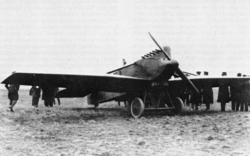Avia BH-3
| Avia BH-3 | |
|---|---|

|
|
| Type: | Fighter plane |
| Design country: | |
| Manufacturer: | |
| First flight: |
December 16, 1921 |
| Commissioning: |
1923 |
| Production time: |
1921-1923 |
| Number of pieces: |
14th |
The Avia BH-3 was a Czechoslovak fighter aircraft from 1921. The design as a monoplane is unusual for its time , as most of the fighters of this era were biplanes .
development
The designers Pavel Beneš and Miroslav Hajn (hence the abbreviation BH) employed by Avia developed the BH-3 from the sports aircraft BH-1bis from 1921, which was also a monoplane construction. The aircraft was made of wood and the wings in a low- wing configuration had a V connected to the fuselage Aspirations.
The starting point for the development was the request made by the Ministry of Defense č.j.293808 vzduchopl./1921 of April 27, 1921, which required the construction of a prototype of the BH-3 at the price of 421,000 CZK (without engine and armament). The first of four prototypes with the designation Av-B-3.01 took off on December 16, 1921 with Bohumil Munzar at the controls for its maiden flight. However, on June 6, 1922, disaster struck when the prototype crashed in the presence of a Ministry of Defense commission and Munzar was killed. However, Avia managed to convince the ministry that the crash had nothing to do with the construction. The work could then be continued. As early as November 1922, the new works pilot Josef Skubal was able to start testing the “replacement prototype” Av-B-3.01. This machine was equipped with a BMW IIIa , while the second prototype received a Hispano Suiza (factory designation BH-4 or Av-HS-3.01). The tests showed satisfactory flight characteristics, which is why the Ministry of Defense signed an order for ten series machines on December 15, 1922 (210,000 Kč per cell). They were delivered to the aviation forces in 1923 under the designation B-3 and flown with the 1st Air Regiment (32nd Fliegerrotte) in Prague-Kbely, whereby the B-3.4 remained at Avia for test purposes and the B-3.7 came to the flying school in Cheb ( later followed by the B-3.6). However, the machines did not stay with the 1st Air Regiment for very long, as they were handed over to the Cheb Aviation School in mid-1924. In 1927 it was withdrawn from service.
The fourth prototype, the B-3.04 , was given a more powerful Walter W IV engine on a trial basis. Since the top speed only increased by 5 km / h, but the mass increased by 17 kg, the project was not pursued any further.
Technical specifications
| Parameter | Data |
|---|---|
| Conception | Fighter plane |
| Constructor (s) | Pavel Beneš / Miroslav Hajn |
| Manufacturer | Avia Akciová Společnost Pro Průmysl Letecký |
| Year of construction (s) | 1921-1923 |
| Wingspan | 10.24 m |
| length | 6.98 m |
| height | 2.77 m |
| Wing area | 15.76 m² |
| Wing loading | 65.0 kg / m² |
| drive | a BMW IIIa in- line engine |
| power | 136 kW (185 hp) |
| Top speed | 225 km / h near the ground |
| Marching speed | 190 km / h |
| Rise time | 10.5 min at 5000 m |
| Service ceiling | 8000 m |
| Range | 450 km |
| Empty mass | 734 kg |
| Launch mass; | 1025 kg |
| crew | 1 pilot |
| Armament | two 7.7 mm rigid Vickers MG 0303 above the engine |
literature
- Michael JH Taylor: Jane's Encyclopedia of Aviation . Studio Editions, London 1989, pp. 86 (English).
- World Aircraft Information Files . Bright Star Publishing, London (English, File 889 Sheet 86).

